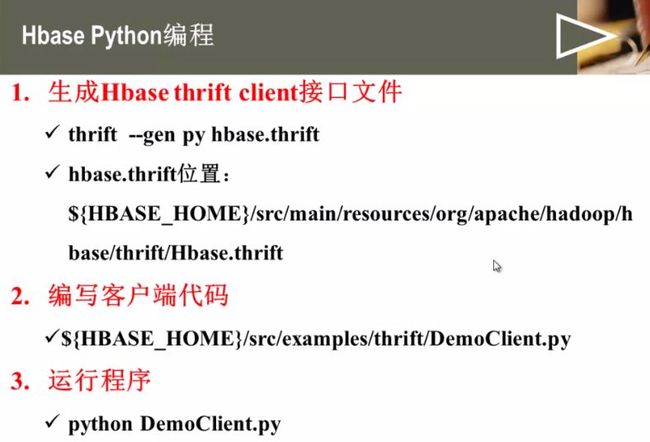python Hbase Thrift pycharm 及引入包
cp -r hbase/ /usr/lib/python2.7/site-packages/
官方示例子
http://code.google.com/p/hbase-thrift/source/browse/trunk/python/test/tables.py
http://yannramin.com/2008/07/19/using-facebook-thrift-with-python-and-hbase/
http://wiki.apache.org/hadoop/Hbase/ThriftApi
将生成的hbase目录copy到python的包下 cp -r hbase /usr/lib/python2.4/site-packages/ 3。启动hbase和thrift服务 ./bin/start-hbase.sh ./bin/hbase-daemon.sh start thrift

好像需要源码,我反正没找到src目录,忘记了 。。。。。。 忘记当初自己怎么装的了。
# --*-- coding:utf-8 --*-- import sys import time # 所有thirft编程都需要的 from thrift import Thrift from thrift.transport import TSocket, TTransport from thrift.protocol import TBinaryProtocol # Hbase的 客户端代码 from hbase import ttypes from hbase.Hbase import Client, ColumnDescriptor, Mutation # make socket 这里配置的是hbase zookeeper的地址,因为master只负责负载均衡,读写由zookeeper协调 transport = TSocket.TSocket('localhost', 9090) # buffering is critical . raw sockets are very slow transport = TTransport.TBufferedTransport(transport) # wrap in a protocol protocol = TBinaryProtocol.TBinaryProtocol(transport) # create a client to use the protocol encoder client = Client(protocol) # connect transport.open() t = 'tab2' # 扫描所有表获取所有表名称 print 'scanning tables ......' for table in client.getTableNames(): print 'found:%s' % table if client.isTableEnabled(table): print ' disabling table: %s' % t # 置为无效 client.disableTable(table) print 'deleting table: %s' % t # 删除表 client.deleteTable(table) # 创建表 columns = [] col = ColumnDescriptor() col.name = 'entry:' col.maxVersions = 10 columns.append(col) col = ColumnDescriptor() col.name = 'unused:' columns.append(col) try: print 'creating table : % s' % t client.createTable(t, columns) except Exception, ae: print 'Warn:' + ae.message # 插入数据 invalid = 'foo-\xfc\xa1\xa1\xa1\xa1\xa1' valid = 'foo-\xE7\x94\x9F\xE3\x83\x93\xE3\x83\xBC\xE3\x83\xAB' # non-utf8 is fine for data mutations = [Mutation(column='entry:foo', value=invalid)] print str(mutations) client.mutateRow(t, 'foo', mutations) # foo is row key # try empty strings # cell value empty mutations = [Mutation(column='entry:foo', value='')] # rowkey empty client.mutateRow(t, '', mutations) #this row name is valid utf8 mutations = [Mutation(column='entry:foo', value=valid)] client.mutateRow(t, valid, mutations) # run a scanner on the rows we just created # 全表扫描 print 'starting scanner...' scanner = client.scannerOpen(t, '', ['entry:']) r = client.scannerGet(scanner) while r: #printRow(r[0]) r = client.scannerGet(scanner) print 'scanner finished ' # 范围扫描 columnNames = [] for (col, desc) in client.getColumnDescriptors(t).items(): print 'column with name:', desc.name print desc columnNames.append(desc.name + ':') print 'stating scanner...' scanner = client.scannerOpenWithStop(t, '00020', '00040', columnNames) r = client.scannerGet(scanner) while r: # printRow(r[0]) r = client.scannerGet(scanner) client.scannerClose(scanner) print 'scanner finished' # 关闭socket transport.close()
现在我们就可以用python来和hbase通信了 #-*-coding:utf-8 -*- #!/usr/bin/python from thrift import Thrift from thrift.transport import TSocket from thrift.transport import TTransport from thrift.protocol import TBinaryProtocol from hbase import Hbase from hbase.ttypes import ColumnDescriptor,Mutation,BatchMutation class HbaseWriter: """ IP地址 端口 表名 """ def __init__(self,address,port,table='user'): self.tableName = table #建立与hbase的连接 self.transport=TTransport.TBufferedTransport(TSocket.TSocket(address,port)) self.protocol = TBinaryProtocol.TBinaryProtocol(self.transport) self.client=Hbase.Client(self.protocol) self.transport.open() tables = self.client.getTableNames() if self.tableName not in tables: print "not in tables" self.__createTable() self.write("hell,babay!!!") self.read() #关闭 def __del__(self): self.transport.close() #建表 def __createTable(self): col1 = ColumnDescriptor(name="person:",maxVersions=1) col2 = ColumnDescriptor(name="contents:",maxVersions=1) col3 = ColumnDescriptor(name="info:",maxVersions=1) self.client.createTable(self.tableName,[col1,col2,col3]) def write(self,content): row="abc" mutations=[Mutation(column="person:",value=content),Mutation(column="info:",value=content)] self.client.mutateRow(self.tableName,row,mutations) def read(self): scannerId = self.client.scannerOpen(self.tableName,"",["contents:",]) while True: try: result = self.client.scannerGet(scannerId) except: break contents = result.columns["contents:"].value #print contents self.client.scannerClose(scannerId) if __name__ == "__main__": client = HbaseWriter("192.168.239.135","9090","person") 我们看下使用thrift生成的代码中都提供了那些方法 提供的方法有: void enableTable(Bytes tableName) enable表 void disableTable(Bytes tableName) disable表 bool isTableEnabled(Bytes tableName) 查看表状态 void compact(Bytes tableNameOrRegionName) void majorCompact(Bytes tableNameOrRegionName) getTableNames() getColumnDescriptors(Text tableName) getTableRegions(Text tableName) void createTable(Text tableName, columnFamilies) void deleteTable(Text tableName) get(Text tableName, Text row, Text column) getVer(Text tableName, Text row, Text column, i32 numVersions) getVerTs(Text tableName, Text row, Text column, i64 timestamp, i32 numVersions) getRow(Text tableName, Text row) getRowWithColumns(Text tableName, Text row, columns) getRowTs(Text tableName, Text row, i64 timestamp) getRowWithColumnsTs(Text tableName, Text row, columns, i64 timestamp) getRows(Text tableName, rows) getRowsWithColumns(Text tableName, rows, columns) getRowsTs(Text tableName, rows, i64 timestamp) getRowsWithColumnsTs(Text tableName, rows, columns, i64 timestamp) void mutateRow(Text tableName, Text row, mutations) void mutateRowTs(Text tableName, Text row, mutations, i64 timestamp) void mutateRows(Text tableName, rowBatches) void mutateRowsTs(Text tableName, rowBatches, i64 timestamp) i64 atomicIncrement(Text tableName, Text row, Text column, i64 value) void deleteAll(Text tableName, Text row, Text column) void deleteAllTs(Text tableName, Text row, Text column, i64 timestamp) void deleteAllRow(Text tableName, Text row) void deleteAllRowTs(Text tableName, Text row, i64 timestamp) ScannerID scannerOpenWithScan(Text tableName, TScan scan) ScannerID scannerOpen(Text tableName, Text startRow, columns) ScannerID scannerOpenWithStop(Text tableName, Text startRow, Text stopRow, columns) ScannerID scannerOpenWithPrefix(Text tableName, Text startAndPrefix, columns) ScannerID scannerOpenTs(Text tableName, Text startRow, columns, i64 timestamp) ScannerID scannerOpenWithStopTs(Text tableName, Text startRow, Text stopRow, columns, i64 timestamp) scannerGet(ScannerID id) scannerGetList(ScannerID id, i32 nbRows) void scannerClose(ScannerID id)
http://blog.csdn.net/poechant/article/details/6618264
http://mmicky.blog.163.com/blog/static/150290154201311801519681/ 按照这个配置python hbase开发环境
编程前切换到/usr/program/python/hbase 然后运行python
>>>from thrift.transport import TSocket
>>>from thrift.protocol import TBinaryProtocol
>>>from hbase import Hbase
都不报错,但是到pycharm报错,原因时python默认搜索当前目录。
到pycharm 需要把 /usr/program/python/hbase 添加到pycharm的path
操作步骤:File>>setting>>project interpreter>>python interpreter>>>paths>>>+ 把/usr/program/python/hbase 文件夹添加进去就好了。
__author__ = 'root' from thrift.transport import TSocket from thrift.protocol import TBinaryProtocol from hbase import Hbase transport = TSocket.TSocket("localhost", 9090) protocol = TBinaryProtocol.TBinaryProtocol(transport) client = Hbase.Client(protocol) transport.open() tabs = client.getTableNames() print tabs